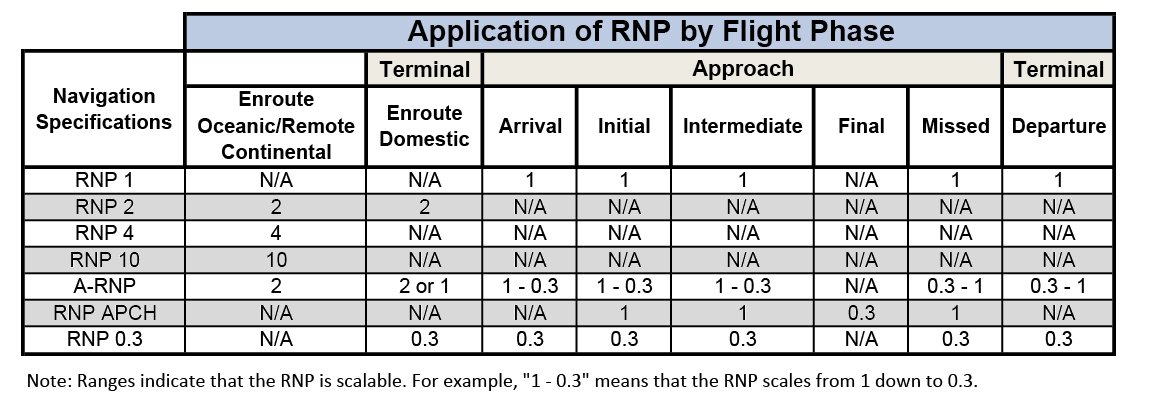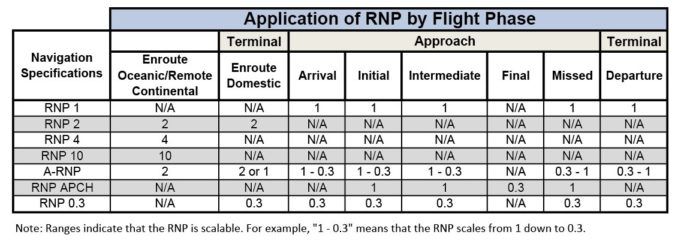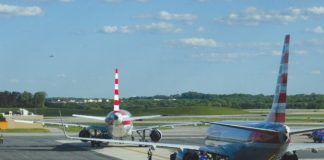Shakespeare elegantly downplays the importance of naming in Romeo and Juliet, writing: “What’s in a name? That which we call a rose by any other name would smell as sweet.” What matters is the subject and not what the subject is called. But this is an over-simplification because changing the subject would make the quote non-sense: That which we call a fish by any other name would smell as sweet. Words have meaning.
The meanings that words convey are particularly important in aviation and are the genesis of a food-fight between ICAO and the FAA. ICAO wants to re-name RNAV approaches RNP and the FAA is balking at the idea—as are many other countries. The controversy surrounds defining RNAV/RNP and what those terms mean to pilots.
A Little Background
(Warning: acronym storm ahead. We don’t make these up; we just explain them.) When area navigation was first used for approaches, a standard and straight-forward naming convention already existed. Approaches were designated based on the system used for lateral guidance in the final approach segment, e.g. ILS, VOR, NDB, GPS, etc.
Each individual system performed to a common standard. Thus, a system used for an approach incorporated two aspects, how navigation information was received (the box) and the required performance of the system. For example, an ILS approach means the localizer is transmitted on a VHF frequency and glideslope on a paired UHF frequency. It also means the localizer and glideslope receivers meet the minimum operational performance standards, or MOPS, of TSO-C36e and TSO-34e, respectively.
All was fine until aviation got too smart for its own good. GPS itself (TSO-
C129) as a supplemental navigation system wasn’t good enough for approaches, so approvals as a normal navigation system (TSO-C145), incorporation of SBAS and selective availability awareness were added. The result is the term “GPS” that is now associated with multiple MOPS.
Peering into the future, GPS is too limited a moniker. GPS refers only to the U.S. satellite system. There are other satellite-based navigation systems such as GLONASS, Galileo and Beidou, and Garmin already makes devices that receive signals from multiple constellations. These are generally referred to as global navigation satellite systems (GNSS).
The FAA has been articulating a performance-based navigation (PBN) strategy since 2003. The idea behind PBN is simple: equipment used doesn’t matter; performance does. If you had an approved navigation device that met the performance requirements, regulators wouldn’t dictate what system to use. This is like saying, “I don’t care if you use Google maps, Apple maps or Mapquest, as long as you make it to the destination.” The problem arises with what to call this when performance is what matters and all we’ve used in the past is device-specific nomenclature.

RNAV and RNP Mess
Enter area navigation (RNAV). From the Pilot/Controller Glossary:
AREA NAVIGATION (RNAV)—A method of navigation which [sic] permits aircraft operation on any desired flight path within the coverage of ground− or space−based navigation aids or within the limits of the capability of self-contained aids, or a combination of these.
Simply put, RNAV is a generic name for any box that allows point-to-point navigation.
A problem with this definition of RNAV is that it doesn’t address performance requirements. Obviously, an old-school LORAN-C won’t have the accuracy of a WAAS-enabled GPS, or even an old rho-theta VOR/DME box. Yet, they’re all called RNAV.
Remember that performance-based navigation (PBN) is a generic term that simply says you can have any box you want as long as it meets the performance requirements. It’s the performance requirements that are expressed as required navigational performance (RNP) and the minimum RNP varies based on the type of usage. For example, enroute navigation requires a rather loose RNP, while a precision approach requires a much tighter RNP. The Pilot/Controller glossary defines RNP as a “statement of the navigational performance necessary for operation within a defined airspace.”
We’ll call the above usage of RNAV and RNP the colloquial definitions.
RNAV and RNP also have specific definitions called navigation specifications. Both RNAV and RNP can do area navigation, but to meet any level of RNP requires onboard position monitoring and alerting. As AC 90-105A states:
Onboard performance monitoring and alerting is the main element that determines if the navigation system complies with the necessary safety level associated to an RNP application. It relates to both lateral and longitudinal navigation performance; and it allows the aircrew to detect that the navigation system is not achieving, or cannot guarantee with 10-5 integrity, the navigation performance required for the operation
Think of RNP as RAIM on steroids. In fact, in a PBN booklet, the Australian government writes, “In an aircraft utilizing a stand-alone GNSS, RNP is achieved through the use of Receiver Autonomous Integrity Monitoring (RAIM).” Here’s the rub: the stand-alone GNSS doesn’t qualify for the navigation specification RNP 0.3.
Simplifying Charts
In the 2000s we’ve seen chart titles turned into alphabet soup. Pilots were having problems identifying what equipment or performance was required. You could have RNAV (GNSS), RNAV (GPS), RNAV (RNP), VOR/DME or GPS charts to the same runway. Internationally, pilots would encounter even more confusing chart titles, such as VOR/DME RNAV or GPS. Does that mean a pilot needs VOR and DME or RNAV or GPS, or is it RNAV based on VOR/DME or GPS? I’d like to buy a comma…
Use of RNP procedures isn’t clear. The RNAV (RNP) Z RWY 27 into San Diego (KSAN) just says “GPS required.” Well I got that and even non-augmented GPS has a 0.3 NM sensitivity that matches the RNP 0.3 minimums line. Pile on varying minimums—LP, LPV, LNAV, LNAV/VNAV to DA or MDA—and it’s easy to understand why Joe Pilot is confused.
The result is that pilots don’t understand requirements, fly approaches not approved or just avoid PBN approaches altogether. ICAO decided to fix it. A state letter was issued in 2013 and new guidance published a year later. The changes standardize PBN charts with three elements; chart identification, PBN requirements box and minimums box.
The ICAO plan, laid out in Circular 336 and Doc 8697, is to retitle RNAV approach charts to RNP. In this case using the colloquial definition—required navigational performance. Every RNAV variant currently employed would change to simply RNP except for authorization-required (AR) procedures. Then the title would read “RNP AR.” The rest of the chart titling scheme would remain the same. Following the navigation type, a letter starting at the end of the alphabet would differentiate multiple approaches with the same navigation to the same runway, followed, of course, by the runway number. An approach title would look like RNP Z 28, if there are two RNP approaches to Runway 28.
The PBN requirements box dictates what navigation specifications and sensors are required. This is similar to the notes currently found on RNAV SIDs/STARs. If the box is empty, any equipment that meets performance can be used. If the box is not empty, only pilots with those navigation specifications or devices can fly the approach. This makes sense because sometimes RNAV systems cannot achieve the accuracy required because of the limits of ground- and space-based navigation.
The last piece of the puzzle was standardizing minimums. Fortunately, this will match the U.S. standard and should be straight forward. The pilot simply picks the minimums based on the performance their equipment can achieve, just like today. If you can fly LPV, fly LPV. If you can’t, fly LNAV/VNAV or simply LNAV.
Not in the U.S.
Early in the discussion of new approach chart titling the FAA identified several problems. In 2011, the Performance Based Aviation Rulemaking Committee (PARC) recommended beginning all PBN Approach procedures with “RNAV” based on avionics capability.
The decision to stick with RNAV was primarily driven by aircraft avionics that display RNAV approaches as “RNV” in the FMS. A report by the PARC noted that not even Airbus 350 and Boeing 787 avionics could display RNP and to change the avionics to display it would “be costly and unlikely to satisfy business cost-benefit analysis.” (PARC recommendations, December 9, 2011)
ATC was also concerned with the change from RNAV to RNP. RNAV rolls off the tongue like a swear-word coming out of a sailor’s mouth (“Aarrrrnav”). Additionally, ATC doesn’t have to read navigation specifications found within the parenthesis of RNAV charts. Adding a chart tile of RNP AR would add verbiage for ATC.
The last point in the PARC report was the workload associated with changing the procedures. Changing titles sounds easy, but coordinating with various chart providers, database suppliers, and stake-holders is not an easy task.
Not mentioned in the PARC report, but likely a factor in the FAA’s decision to not comply with ICAO’s guidance, is the fear that GA might interpret RNP in the title as an ability to fly to RNP minimums (mistaking the colloquial definition for a navigation specification). There is no RNAV 0.3 navigation specification to throw an unknowing pilot into a minimums tail spin. But there is an RNP 0.3, for example. The nuance between the colloquial definition and navigation specification is subtle and ripe for confusion.
The International Coordinating Council of Aerospace Industries Associations (ICCAIA) is getting on the no-to-RNP bandwagon. At ICAO’s 39th assembly, ICCAIA noted the following in a working paper.
As the changes are beginning to be implemented, new information is surfacing concerning the impacts of the changes on flight deck human factors. Manufactures’ human factors experts believe these changes are likely to impact safety negatively. ICAO’s initial assumption that no on-board equipment changes would be necessary has been found to be incorrect.
ICCAIA also mentions that ICAO failed to adequately address the concerns in the PARC 2011 report. The organization noted that by 2016, only nine states have published charts with the new title with compliance less than one percent of PBN charts globally.
Advisory Committees and the FAA
The job of a body like the FAA is to regulate and promote while minimizing the number of folks who get upset. Rocking the boat is frowned upon generally and specifically. Agencies learned they could deflect criticism by enacting policies based on industry advisory committees. As a Congressional Research Service report on advisory committees stated:
Federal advisory committees—which may also be designated as commissions, councils, or task forces—are created as provisional advisory bodies that can circumvent bureaucratic constraints to collect a variety of viewpoints on specific policy issues…These committees are often created to help the government manage and solve complex or divisive issues. Such committees may be mandated to render independent advice or make recommendations to various bodies within the federal government. (2009)
Advisory committees create a consensus recommendation that the regulator then implements (for the most part).
This setup can lead to regulatory capture, which is defined as a “form of government failure that occurs when a regulatory agency, created to act in the public interest, instead advances the commercial or political concerns of special interest groups that dominate the industry or sector it is charged with regulating.” (Wikipedia) To prevent regulatory capture the Federal Advisory Committee Act of 1972 puts certain requirements on committees, including a public notice in the Federal Register.
One of the most influential groups to pilots is the Performance-Based Aviation Rulemaking Committee, or PARC. Described on the FAA website:
The PARC provides a forum for the United States (U.S.) aviation community to discuss, prioritize, and resolve issues, provide direction for U.S. flight operations criteria and produce U.S. consensus positions for global harmonization. PARC input was invaluable in the drafting of the Roadmap for Performance-Based Navigation, and they have helped update numerous FAA regulatory documents as well.
You can view the PARC Charter and other information by searching the FAA website. —JM
What Now?
With the U.S. not complying with ICAO guidance for PBN charts and growing international recognition of the challenges, the chances of seeing RNP-titled charts are slim. So, what are the key take-aways?
The first is recognizing the difference between general definitions and navigation specifications. Chart titles are based on general definitions and minimums are based on navigation specifications. Navigation specifications in the U.S. are found in parenthesis on chart titles, notes sections or PBN requirements box. “GPS” in RNAV (GPS) is the nav spec. You will also see navigation and equipment specs on SIDS and STARS. For example, on the TNNS RNAV departure from KLGA the notes state either GPS or DME/DME/IRU navigators can be used and they meet RNAV 1 accuracy.
AC 90-105A, Approval Guidance for RNP Operations…, defines navigation specification for Part 91 pilots based on the TSO of the installed equipment. Basically, any IFR GPS (TSO-C129, -C145, -C196) qualifies for use of RNP 2, RNP 1, RNP APRCH. Which RNP APRCH mins? LNAV or LNAV/VNAV depending on equipment. LNAV/VNAV requires TSO-C146 Class 2 or 3.
It’s important to note, none of the navigations specifications associated with installed equipment include procedures that have “authorization required” on the chart. Also, LP and LPV approaches are covered in a different AC.
Everyone agrees that adding a PBN Requirements box is a good idea. This box will contain navigation specification, sensor requirements and additional functional requirements such as radius to a fix (RF). Whatever happens with chart titles, you’ll be prepared.
Before spending the summers washing planes and flying, Jordan Miller worked at a Shakespeare camp for kids. Acting skills reappear occasionally as a CFII and ATP.






Can I reprint this in a newsletter for my organization?